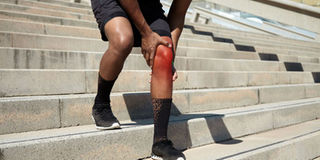Manage your arthritis with exercise

As you consider starting an arthritis exercise program, understand what’s within your limits and what level of exercise is likely to give you results.
What you need to know:
- If an hour after you have finished exercising, you are still aching or feel more sore than when you started, you may have overdone it.
- Should pain set in, Bwana suggests the use of knee braces.
- Apart from strengthening the quadriceps, you also need to work on the hamstring curls - muscles along the back of your thigh.
Resty Nakimbugwe had battled painful knees for quite a while before she was diagnosed with arthritis. Due to the pain, movement became cumbersome with time. “Although I had lived an active life, I started slowing down because sometimes the pain would become intense,” Nakimbugwe says. With time, she even stopped bothering to take a simple walk. “That came with weight gain, which made the pain worse,” she shares.
Arthritis is when there is wear and tear of joints and cartilages. It affects people in various ways. However, Norbert Bwana, a physiotherapist at Physique Physiotherapy Services, says when one gets arthritis in the knees and ankles, weight loss is very important. “Excess weight would make the pain excruciating,” he says. However, since arthritis comes with pain, there are some exercises that these persons may not indulge in. Bwana says these include running where one has to wholly bear their weight.
Robert Ddamulira of Robbie Fitness, suggests some exercises that these persons can do in order to either reduce weight or keep the weight at bay.
Stip-ups
Find a raised platform such as a step or board and slowly step on it as you raise the other leg. It is important that one does the exercise slowly so as not to make the knees or ankles hurt more.
Squats
These can be single leg squats or both legs. However, depending on the level of arthritis, the squats could be painful. Therefore, modifying them would be great to help in building strength and balance.
Start while seated; say on a chair, then stand, keeping your weight on your heels. That stops your knees from shifting forward. Then sit again and repeat. If that is not working, you could stand with a fitness ball between your back and a wall. Then press on the ball as you slowly lower yourself toward the floor.
Muscle strengthening
Bwana adds that apart from weight reduction, there is need to strengthen the muscles that support your knees and keep them flexible. Hence the need for muscle strengthening exercises. One of such exercises is one that strengthens the quadriceps (upper thigh muscles). However, these must be done without putting a lot of weight on your knees.
For example, lie on your back on the floor or any flat surface. Then bend one knee, placing your foot flat on the floor while keeping the other leg straight. Raise the straight leg to the height of the opposite knee. Repeat the work out for about 10-15 times in a slow manner.
Apart from strengthening the quadriceps, you also need to work on the hamstring curls - muscles along the back of your thigh. To do that, lie flat on your stomach and slowly bring your heels as close to your bottom as possible and maintain that position. Just like with the upper thigh muscles, do these for 15 minutes.
Apart from lying down, you can do the exercise while standing as you hold on to a chair or table and lift one leg at a time. With time, it will get easier making it possible to add ankle weights during the exercise. Gradually increase the weights to make the exercise more effective. However, Bwana advises against straining a lot as that will intensify the pain.
Knee braces
Should pain set in, Bwana suggests the use of knee braces. “There are various types, such as the elastic ones. Get the one that suits your level of arthritis to reduce the pain and the impact of the weight,” he advises.
One can also use a cold compress for 10 minutes, tops to relieve the pain. “Beyond 10 minutes may cause a cold burn,” Bwana cautions.
How will I know if I have overdone it?
If an hour after you have finished exercising, you are still aching or feel more sore than when you started, you may have overdone it. You should feel as if your muscles have done some work and have stretched a little after exercise, but you should not be exhausted or in more discomfort. Have a rest for the following day and start again the day after, but halve the amount of exercise. Then gradually increase it by a few minutes each day. If you have overdone it, particularly if a joint is hot or swollen, cover the joint with an ice pack wrapped in a damp towel for 10–15 minutes.




